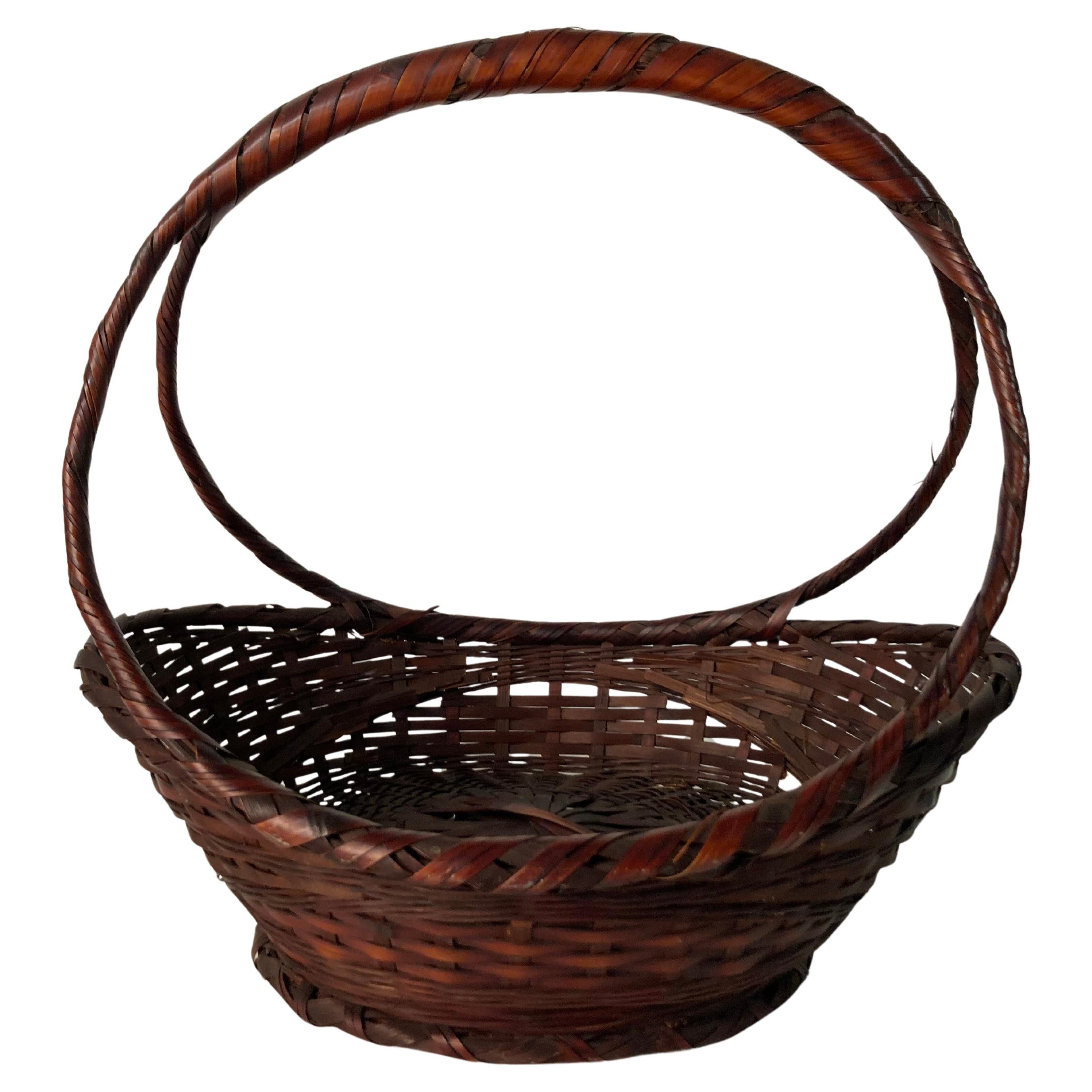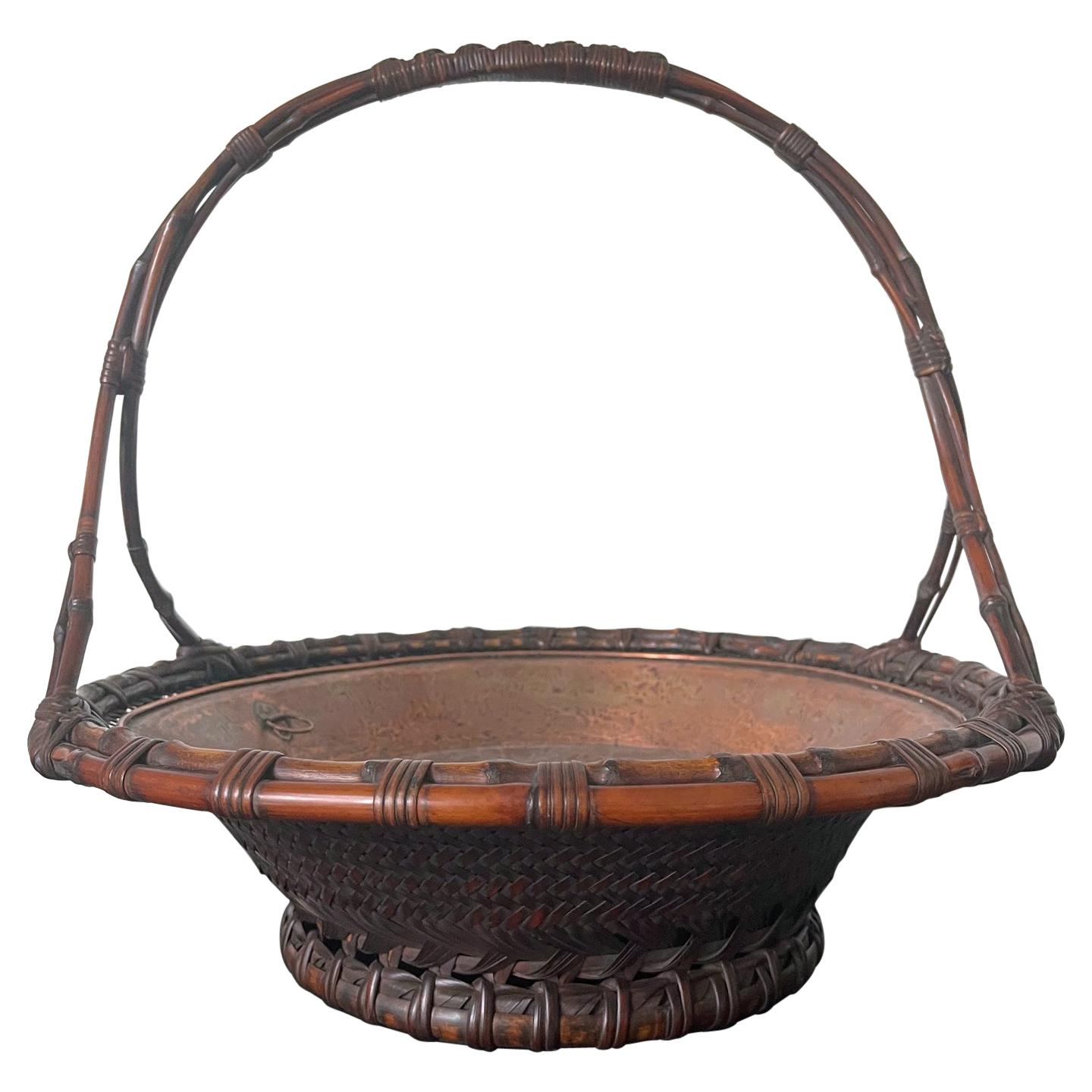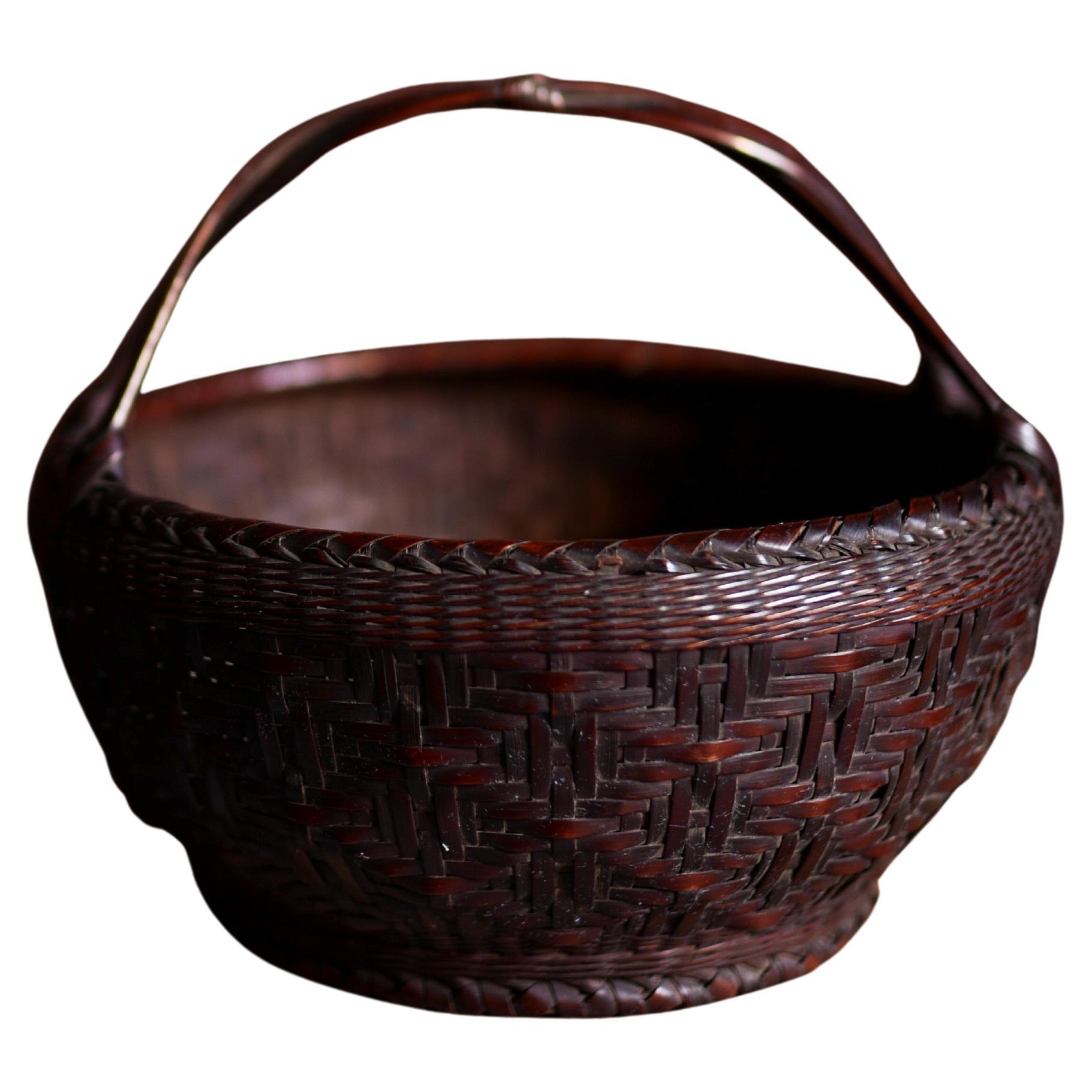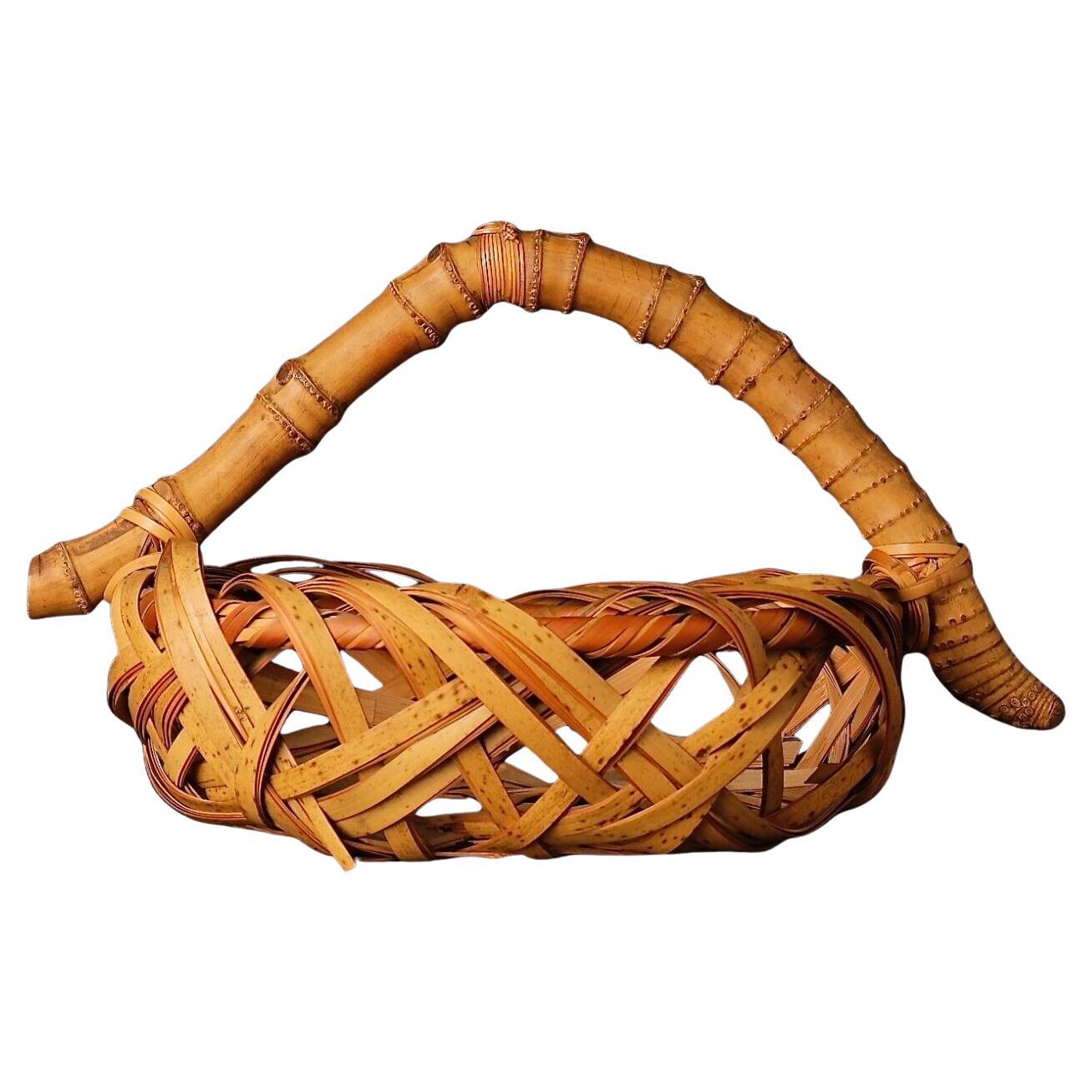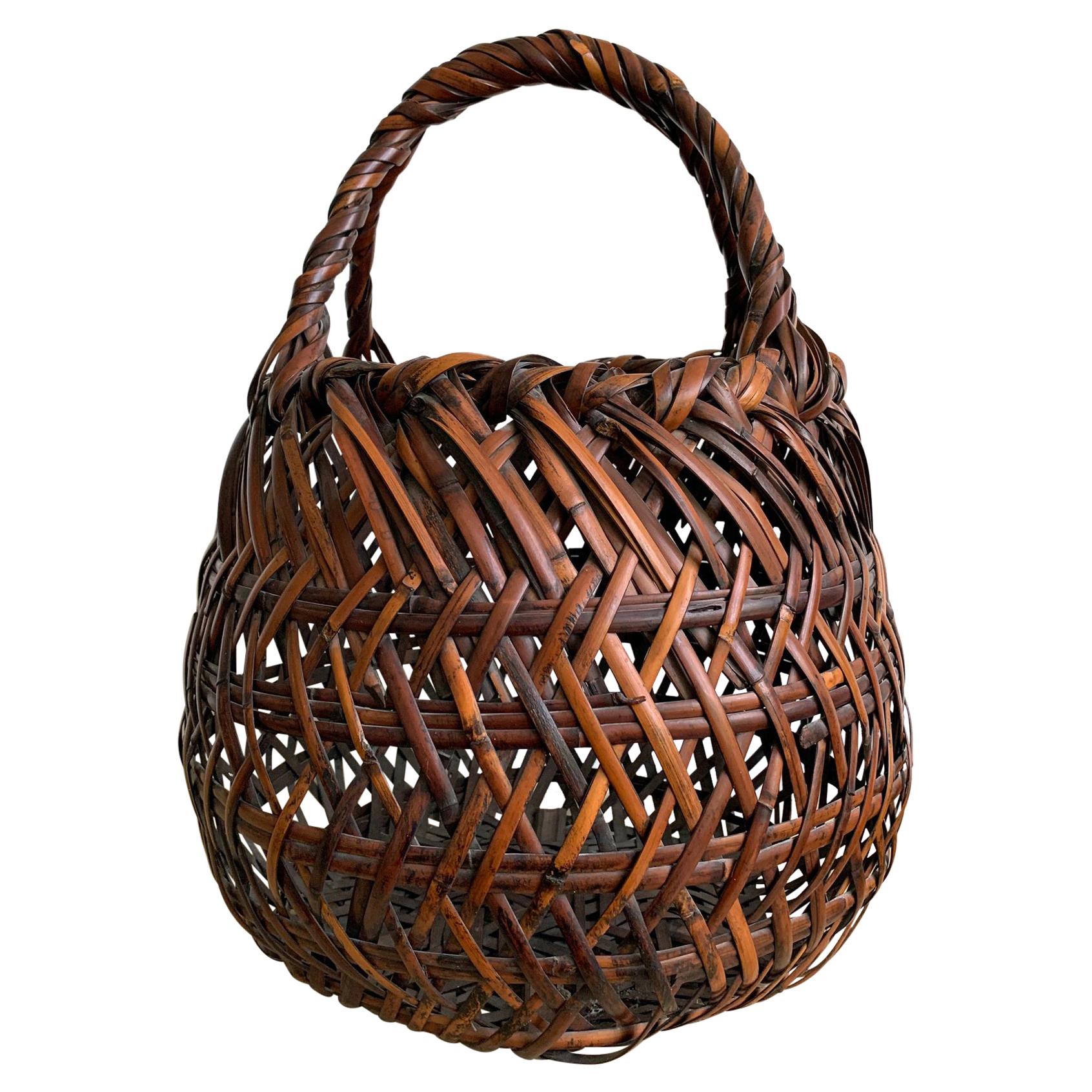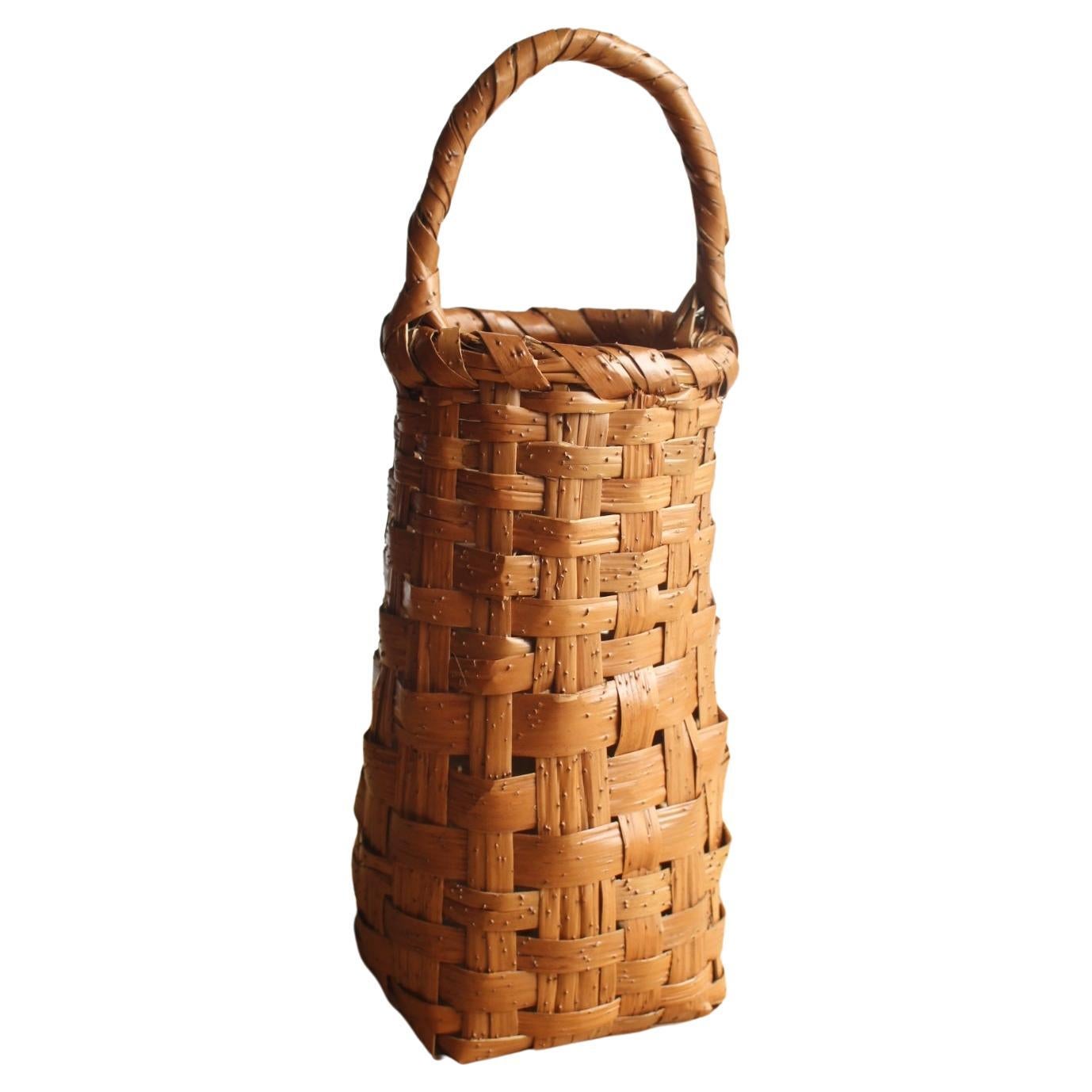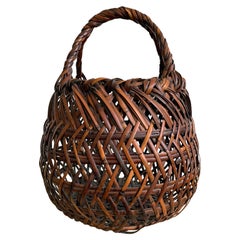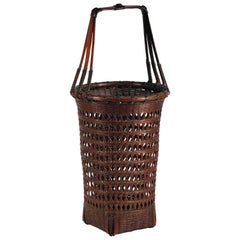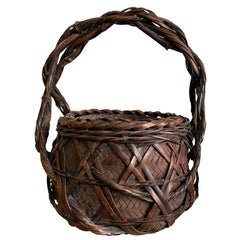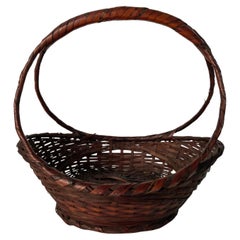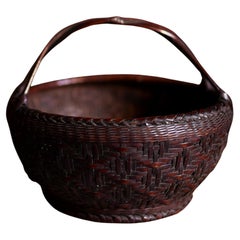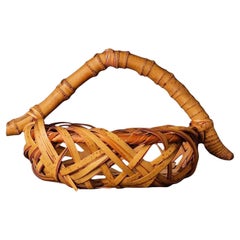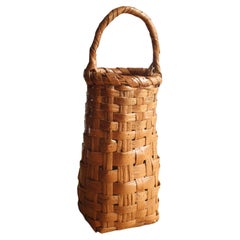Items Similar to Important Miniature Japanese Bamboo Basket by Hayakawa Shokosai I
Want more images or videos?
Request additional images or videos from the seller
1 of 15
Important Miniature Japanese Bamboo Basket by Hayakawa Shokosai I
$6,800
£5,136.07
€5,935.81
CA$9,538.04
A$10,608.75
CHF 5,552.39
MX$129,391.77
NOK 69,767.84
SEK 65,625.66
DKK 44,305.09
About the Item
A miniature bamboo basket woven by Hayakawa Shokosai I (1815-1897) circa 1885, an important example of the work by the artist who is considered as the founding father of Japanese modern bamboo art and the first ever signed his own work thus elevating bamboo weaving from a craft into an art form. The miniature basket was traditionally used during Sencha tea ceremony. It was woven from bamboo (madake) and rattan using a wide range of techniques including hexagonal plaiting, twining, twill plaiting and circular plaiting base. It was signed underneath Shokosai.
Near identical pieces were in Lloyd Cotsen Japanese bamboo basket collection, 2006.3.289.
See also Master of Bamboo, Melissa M. Rinne. Page 49.
- Creator:Hayakawa Shokosai I (Artist)
- Dimensions:Height: 4 in (10.16 cm)Diameter: 4 in (10.16 cm)
- Style:Japonisme (Of the Period)
- Materials and Techniques:
- Place of Origin:
- Period:
- Date of Manufacture:1880s
- Condition:Wear consistent with age and use. Fine antique condition with very minor wear on the surface.
- Seller Location:Atlanta, GA
- Reference Number:1stDibs: LU945014386752
About the Seller
4.9
Platinum Seller
Premium sellers with a 4.7+ rating and 24-hour response times
Established in 2006
1stDibs seller since 2010
567 sales on 1stDibs
Typical response time: <1 hour
- ShippingRetrieving quote...Shipping from: Atlanta, GA
- Return Policy
Authenticity Guarantee
In the unlikely event there’s an issue with an item’s authenticity, contact us within 1 year for a full refund. DetailsMoney-Back Guarantee
If your item is not as described, is damaged in transit, or does not arrive, contact us within 7 days for a full refund. Details24-Hour Cancellation
You have a 24-hour grace period in which to reconsider your purchase, with no questions asked.Vetted Professional Sellers
Our world-class sellers must adhere to strict standards for service and quality, maintaining the integrity of our listings.Price-Match Guarantee
If you find that a seller listed the same item for a lower price elsewhere, we’ll match it.Trusted Global Delivery
Our best-in-class carrier network provides specialized shipping options worldwide, including custom delivery.More From This Seller
View AllLarge Japanese Woven Bamboo Morikago Basket by Maeda Chikubosai I
By Maeda Chikubosai
Located in Atlanta, GA
A large and impressive Japanese basket in the form of a morikago by Maeda Chikubosai I (1872-1950) circa first half of the 20th century. Chikubosai I was from the Kansai Region and active in Sakai, Osaka prefecture. He was instructed by Wada Waichisai I, (1851-1901).
Morikago is a shallow open basket with handle. It was traditionally used to display fruits, sometimes flowers, during Sencha tea ceremony. In contrast to Chanoyu, Sencha ceremony uses loose green tea leaves instead of tea powder. The placement of loose fruits in the basket meant that the pattern of the bottom, which is often elaborate, was meant to be visible.
This morikago was beautifully constructed with bent bamboo frame and twill plaits for the body. The bottom of the basket features a double diamond pattern achieved with a variation of plover plait. The bifurcated handles was bundle-plated with a rather free spirit approach. They show a poetic suggestion of movement, as if the bamboos were still swaying in the wind. The basket has a copper insert that fits perfectly and it is quite possibly the original. The basket is signed on the base "Chikubosai". The style of the signature shows that it was made by Maeda Chikubosai I.
For another Morikago basket by Maeda Chikubosai I, see page 79 of "Masters of Bamboo" by Rinne.
For the study of the signature of Chikubosai I "Baskets Master Pieces of Japanese Bamboo Art...
Category
Early 20th Century Japanese Japonisme Decorative Baskets
Materials
Copper
Japanese Bamboo Ikebana Basket by Yamamoto Chikuryosai I Shoen
Located in Atlanta, GA
An important Japanese bamboo Ikebana basket by Yamamoto Chikuryosai I (also known as Chikuryusai I, Shoen after 1929) (1868-1945). Active in Osaka, Kansai region, he was advised by Wada Waichisai I. After 1929, he signed his work as Shoen (Shoen made this), such as this one.
This basket was made using "sooted" bamboo (susutake in Japanese). This bamboo materials was collected from traditional thatched-roof houses that had been exposed to decades of smoke from a hearth or cooking fire, therefore the basket displays a deep rich patina that is hard to attain by color-lacquering. The basket featured a large rounded barrel form with handle. The body was constructed with a twill plaiting variation of a more relaxed and loose weave. It allows the light coming through to render the piece a lighter sense. Parallel plaiting was used to reinforce the body with stripes of bamboo, while adding more visual constrict to a free spirited background. Twisted bamboo strips form rope-like handle and the top rim. It is signed "Shoen Made This" on the base. Two-piece water container made from bamboo trunk is retained with the piece as shown.
For the artists other and similar work, see baskets masterpieces of Japanese Bamboo Art...
Category
Vintage 1930s Japanese Japonisme Decorative Baskets
Materials
Bamboo
Japanese Bamboo Basket Ikebana by Yamashita Kochikusai
By Yamashita Kochikusai
Located in Atlanta, GA
Yamashita Kochikusai (1876-1947) was a bamboo artist from Osaka, Kansai region. He apprenticed under Wada Waichisai I (1851-1901), becoming independent in 1901. His students include ...
Category
Vintage 1920s Japanese Japonisme Decorative Baskets
Materials
Bamboo
Japanese Wagumi Handled Bamboo Basket Ikebana
Located in Atlanta, GA
Bold, rustic and with an earthy free spirit, this wagumi style flower basket with twisted handle (ikebana) was designed and woven to evoke a sense of serenity and humbleness during t...
Category
Vintage 1920s Japanese Japonisme Sculptures and Carvings
Materials
Bamboo
Japanese Woven Ikebana Bamboo Basket Maeda Chikubosai I
By Maeda Chikubosai
Located in Atlanta, GA
A tall woven bamboo ikebana hanakago (flower basket) circa first half of the 20th century (Taisho or Showa era) by Japanese bamboo master Maeda Chikubosai I (1872-1950). Hand-woven w...
Category
Early 20th Century Japanese Modern Vases
Materials
Bamboo
Japanese Woven Ikebana Bamboo Basket Maeda Chikubosai I
By Maeda Chikubosai
Located in Atlanta, GA
A woven bamboo ikebana hanakago (flower basket) with handle circa first half of the 20th century (Taisho or Showa era) by Japanese bamboo master Maeda Chikubosai I (1872-1950). In th...
Category
Early 20th Century Japanese Modern Vases
Materials
Bamboo
You May Also Like
Fine Japanese Split Bamboo Flower Gathering Basket for Ikebana
Located in Bridgeport, CT
A well crafted and elegant Japanese Flower Gathering Basket crafted from split and wound Bamboo in a fine deep stain. With a joined double ring handle and upturned oval basket. Signe...
Category
Mid-20th Century Japanese Edo Decorative Baskets
Materials
Bamboo
Japanese Handwoven Bamboo Basket with Handle, Hanakago, Japan, 20th Century
Located in Edogawa-ku Tokyo, JP
A finely crafted Japanese a handwoven bamboo basket with an arched handle.
Made from naturally darkened bamboo, the basket features an intricate geometric weave and a gracefully cur...
Category
Early 20th Century Japanese Decorative Baskets
Materials
Bamboo
Early 20th c. Stunning signed Bamboo Basket by Kosuge Kogetsu
Located in Fukuoka, JP
Elegant Bamboo Basket by Kosuge Kogetsu ( 1932-2016 )
This refined bamboo basket was crafted by Kosuge Kōgetsu, a master bamboo artist who began his career under the tutelage of hi...
Category
Early 20th Century Japanese Showa Decorative Baskets
Materials
Bamboo
Japanese Antiques a basket by Chikuryu-sai Yamamoto(山本竹龍齋) lotus Bamboo
Located in Niiza, JP
Material: lotus and bamboo
Made by Yamamoto Chikuryusai,
a bamboo craftsman from Osaka Prefecture.
Chikuryusai took the name "Yamamoto Shoen 山本笙園"
in his later years.
Because he...
Category
Vintage 1920s Japanese Antiquities
Materials
Bamboo
Japanese Flat Ikebana Basket, Bamboo, Suruga Sensuji Style
Located in Clifton Springs, NY
Vintage bamboo Ikebana basket features an elongated, flattened form with prominent rounded handle. The basket is woven of thin round bamboo strips that are secured with transparent ...
Category
Mid-20th Century Japanese Folk Art Decorative Baskets
Materials
Rattan, Wicker, Bamboo
Intricately woven Japanese art basket, 1900-50
Located in Kenilworth, IL
Vintage Japanese open top woven basket. The basket features a broad bent bamboo handle which is reinforced by angled bamboo stays lashed to the handle at both the bend in the handle ...
Category
Early 20th Century Japanese Decorative Baskets
Materials
Bamboo, Rattan
More Ways To Browse
Antique Japanese Basket
Japanese Antique Bowls
Japanese Weaving
Japanese Rattan Furniture
Rattan Japan
Woven Bamboo Basket
Antique Bamboo Baskets
Japanese Bamboo Basket
Antique Rattan And Bamboo
Japanese Woven Basket
Signed Bamboo Basket
Antique Miniature Baskets
Rattan Twin
Antique Japanese Woven Baskets
Vintage Baskets With Handles
Woven Baskets
Lidded Basket
Lidded Baskets
